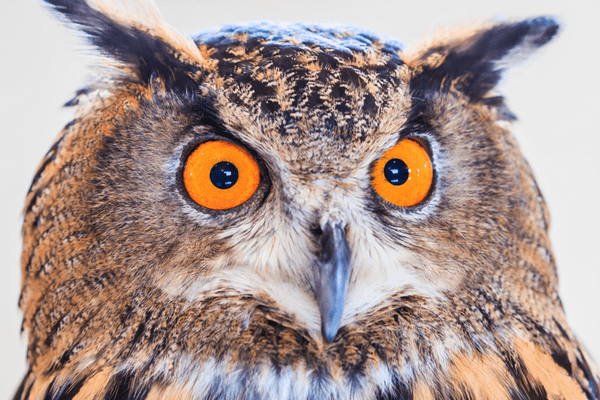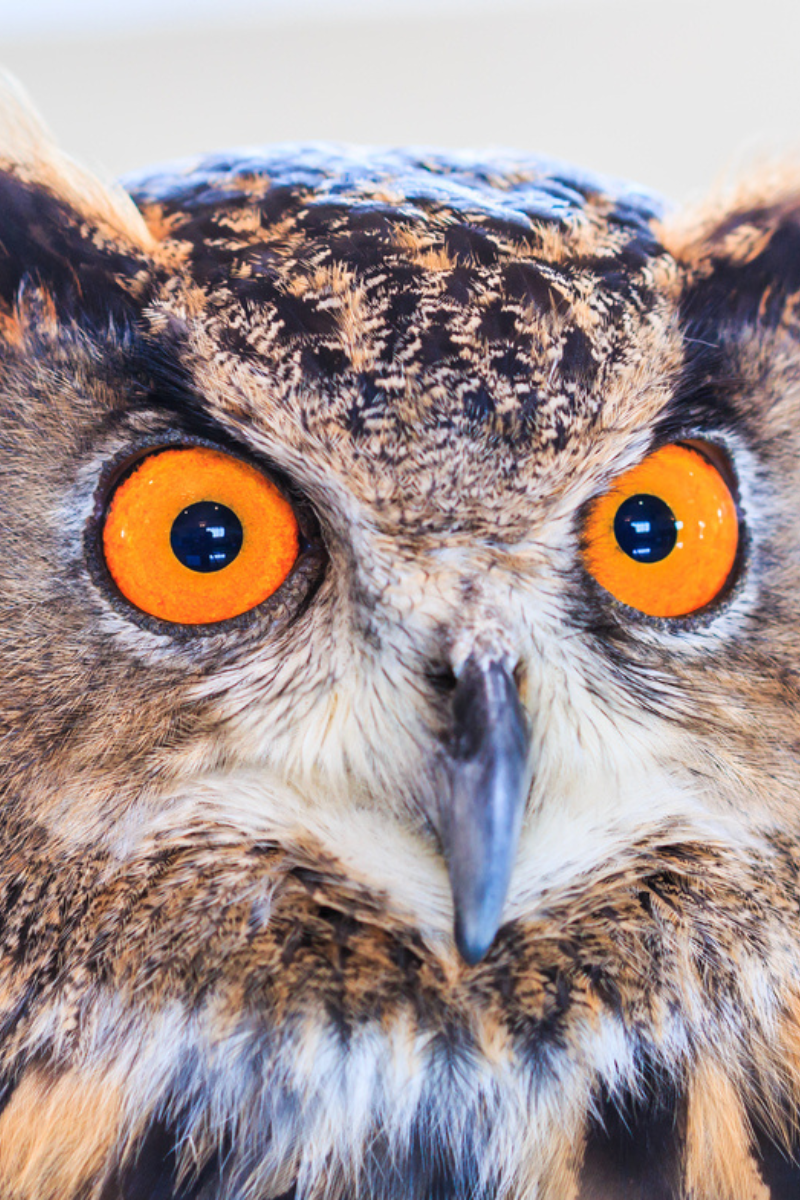Contents
The horned owl and eagle-owl are both members of the Bubo genus. The horned owl possesses the scientific name Bubo virginianus. And the Eagle-owl, better known as the Eurasian Eagle-owl, has the scientific name Bubo bubo.
Other names for the horned owl include the Tiger Owl, the Winged Tiger, or the Tiger of the Air. The Eagle-owl is better known as the Eurasian Eagle-owl and it has many relatives including snowy owls, great horned owls, Fraser’s Eagle-owl, and a number of other similar species from the same family.
There are 20 different species found within this genus. These owls are located all around the world. And they are a member of the Strigiformes order, which means they are traditionally some of the largest living owls in the world.
In the past, this genus only represented owls with ear tufts. But this isn’t the case any longer.
Today, I’d like to share a wide range of other important and interesting facts with you about horned owls and Eagle-owls. The topics I’ll cover include:
- Important facts about horned owls and Eagle-owls
- How to identify each owl type
- The differences between males and females of each species
- Dietary and feeding preferences
- Behaviors, nesting habits, and migration patterns
- Other fun and interesting facts
Keep reading to learn more about horned owls and eagle owls right now.
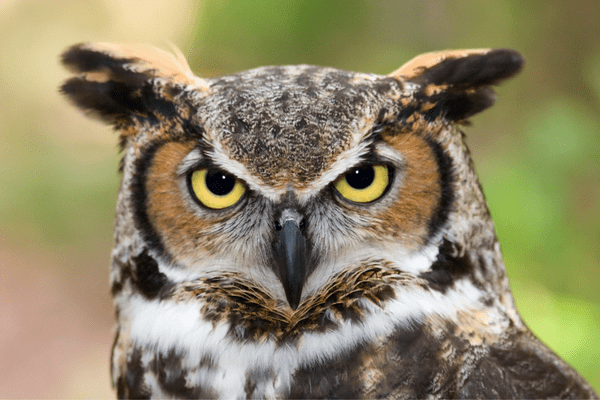
Horned owl facts
- Common Name: Horned owl
- Scientific Name: Bubo virginianus
- Scientific Family: Strigidae
- Life Span: 13 years
- Size: 17.0 to 25.0 inches
- Wingspan: 36.0 to 60.0 inches
- Weight: 43.2 to 88.0 oz
- Conservation status: Least Concern
Horned owl: how-to identify
Identifying horned owls and eagle owls is fairly easy to accomplish. They have tufts of feathers sticking up above their eyes that look like horns. They aren’t actually horns, as I’ve just said, but they definitely appear that way.
Besides the ear tufts, they also have barred feathers and a white patch of feathers underneath the throat. When these birds are vocalizing, this white patch will expand and grow bigger.
Eagle owls also have ear tufts, modeled feathers, and bright orange eyes. They are visually beautiful and very striking animals. They also have strong and powerful feet that they can use to grip their prey. Their talents are so strong that it requires massive amounts of pressure to open them up.
Differences Between Male & Female
Just like horned owls, male eagle owls look very similar to their female counterparts. The major significant differences are that the females are a lot larger than the males and they certainly way more as well.
Another difference is the male ear tufts stand upright much more than the females, so they look a lot pointier. In fact, female ear tufts tend to droop downward.
Finally, the male has a larger voice box, so it has much deeper calls than female horned owls and eagle owls.
Differences In Summer Plumage vs Winter Plumage
There aren’t any significant differences between Summer and Winter plumage. These owls tend to have a relatively thick coat of extremely soft feathers.
The one real difference to point out is the colors of their feathers in different regions. Their colors tend to remain browner or sooty in warmer regions in the United States as far as great-horned owls are concerned. But in Canada and further north, their feathers are nearly pure white, which is one significant difference.
Eagle owls tend to remain brown in color for the most part. Yet their bodies will have black or dark brown markings on them. And they have very noticeable and attractive orange eyes. But their plumage doesn’t change at all with the seasons.
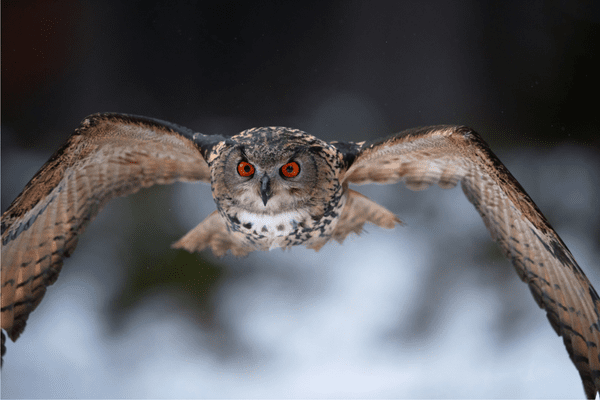
Where You’ll See Horned Owls
Horned owls tend to live in the United States and Canada, whereas Eagle-owls roam the Palearctic eco-regions of northern Africa, Europe, north of the Himalayan foothills in Asia, and north-central parts of the Arabian Peninsula.
Horned owl bird migration
For those living in the United States looking to spot their favorite horned owls in the wild, you should have no trouble finding them. They are in plentiful supply and you won’t even have to travel out of your state to see them because they are well represented in all of the lower 48 states and Alaska but you’ll have a tough time finding them in Hawaii.
As mentioned above, eagle owls are a Least Concern designated species, which means they are in plentiful supply. Individuals living in Europe, northern Africa, parts of Asia, and the Arabian Peninsula will have no trouble finding these gorgeous owls in their beautiful orange eyes because they are represented in abundance.
Horned owl diet
The horned owl is a well-known predator that is relatively aggressive and consumes small to medium-sized prey. They eat all kinds of mammals, birds, insects, reptiles, and fish. This animal will consume squirrels, mice, hawks, ducks, snakes, lizards, rabbits, rats, upon sums, skunks, and more.
Eagle owls, being in the same genus as horned owls, basically consume a similar diet. They’ll eat rats, voles, raptors, woodpeckers, rabbits, snakes, amphibians, fish, insects, and any other prey that they can get their hands on.
Be careful keeping them around your pets. They have been known to snatch up cats and small dogs that way up to as much as 15 pounds.
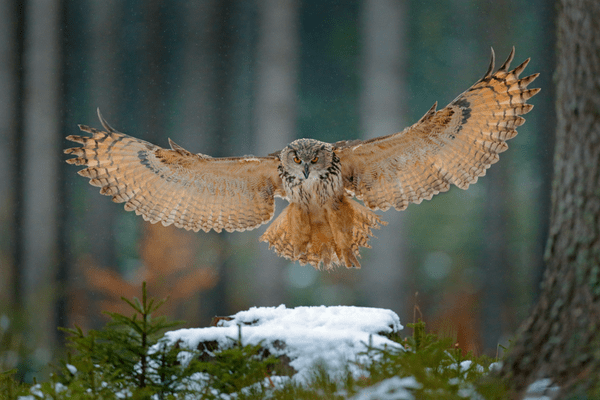
Horned owl nesting
- Clutch Size: 1-4 eggs
- # of Broods: 1 brood
- Incubation Period: 30-37 days
- Nestling period: 40-42 days
- Egg Description: Dull White, White
Horned owls typically build their nests in trees like junipers, cottonwoods, beech trees, and pine trees. They also build nests in tree cavities, deserted buildings, cliff edges, and dead snags.
On occasion, you’ll even find a horned owl nest on the ground. The couple will build their nest together, protect together, and keep it safe before laying eggs.
Eagle owls are in plentiful supply throughout Asia and Europe and parts of northern Africa. Their nests and habitats are commonly found on cliffs, rocky outcroppings, semi-arid areas, grasslands, steps, and farmland.
They also like to build their nests in cave entrances, on ledges, and within rock crevices located on cliffs. They also adopt abandoned nests from other large birds like eagles or ravens and occasionally they also build nests on the ground.
After their hatchlings are born, they will remain in the territory of their parents for around 3-4 months. Afterward, they will leave the nest and leave the area and develop their own territory and find a mate.
Horned owl behavior
Eagle owls are typically solitary creatures. And like their horned owl counterparts, they are also nocturnal creatures as well. They tend to remain active at night the most. During the nighttime, they typically tend to hunt for food.
Eurasian Eagle-owls are also quite territorial. If a predator encroaches on their territory, they will attack and also defend their land. It doesn’t matter if the predator is a different creature or another owl, they will defend their area.
As it gets closer to breeding season, eagle-owl pairs tend to reunite. At this stage, they will start building their nest so the female eagle owl can then lay eggs.
Horned owls are also very similar to eagle owls as far as behaviors are concerned. They like to hunt at night right and this is particularly true at dusk. They like to get their hunting in right before dawn. But if they have a low food supply, they will hunt throughout the evening and into the morning during daylight when necessary.
Horned owls are monogamous creatures that are also nocturnal, so the bulk of their waking hours are spent defending and protecting their territory and growing their family during the night. These predators are aggressive during the winter and remain that way until the female lays eggs in their territory.
How-to attract horned owls
Believe it or not, it’s pretty easy to attract eagle-owls and horned owls using the same techniques. These creatures do not mind nesting in man-made structures. One way to gain their attention is to build a nesting box that’s large enough for them to live in as a family.
They also like to bathe and keep themselves clean. Putting a large birdbath in your backyard for them to clean and drink out of is definitely an effective way to get their attention.
As aggressive predators, they really enjoy hunting. Keeping your grass longer will attract small rodents, squirrels, and other ground-dwelling animals. This will be very appealing to the predatory nature of horned owls and eagle owls.
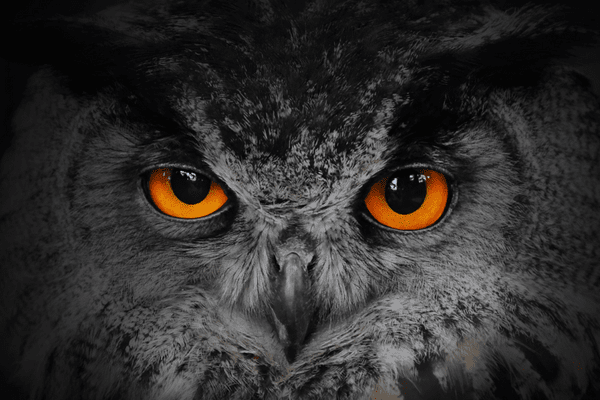
Horned owl threats
Both horned owls and eagle owls are designated with a Least Concern conservation status. This means these owls are members of an abundant species. They aren’t in any danger and they aren’t on the verge of becoming extinct, which is, unfortunately, the case for many other birds and different species.
Horned owl fun & interesting facts
- Eagle-owls use long and fast glides combined with shallow wing beats to create powerful and very fast flights. They can soar through the sky on updrafts, which makes their flight patterns very similar to the red-tailed hawk.
- Eagle owls from Eurasia are considered some of the largest owls in the entire world.
- Eurasian Eagle-owls also have feathery ear tufts and orange eyes. These features are incredibly attractive, which makes this owl one of the most striking in the entire world.
- Horned owls have incredibly strong talons, which is extremely similar to eagle owls. It takes as much as 28 pounds of pressure to open up tightly clenched horned owl talons.
- The feathers of both owl species are very soft and supple. They are designed this way to keep them warm in cold winters. It also makes it easy for them to fly using stealth because the soft feathers do not rustle or make loud noises.
- Both horned owls and eagle-owls have females that are larger than their male counterparts. They have bigger bodies and weigh more than males.
- Verreaux’s Eagle-Owl
- Snowy Owl
- Great Horned Owl
- Cape Eagle-Owl
- Spot Bellied Eagle-Owl
- Usambara Eagle-Owl
- Philippine Eagle-Owl
- Lesser Horned Owl
- Arabian Eagle-Owl
- Indian Eagle-Owl
- Eurasian Eagle-Owl
- Grayish Eagle-Owl
- Pharaoh Eagle-Owl
- Fraser’s Eagle-Owl
- Spotted Eagle-Owl
- Blakiston’s Fish Owl
- Dusky Eagle-Owl
- Shelley’s Eagle-Owl
- Barred Eagle-Owl
- Akun Eagle-Owl

